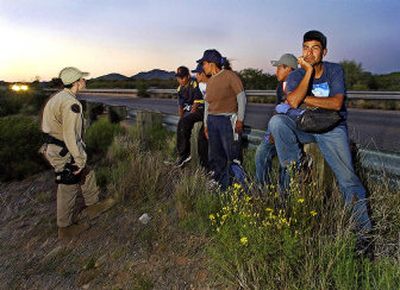Death toll among border-crossers hits record

TUCSON, Ariz. – A record 460 illegal migrants died crossing the U.S.-Mexico border in the last year, a toll pushed higher by unusually hot temperatures and a shift of illegal migration routes through the remote desert.
The death total from Oct. 1 through Sept. 29 surpassed the previous record of 383 deaths set in 2000, according to statistics compiled by the U.S. Border Patrol.
The dead were mostly Mexicans, many from the states of Mexico, Guanajuato and Veracruz, but also from the impoverished southern states of Oaxaca and Chiapas.
Migrants continue to die in automobile accidents and from drownings while crossing roads and waterways into California and Texas, but 261, or more than half the total, perished while crossing the Arizona deserts, the busiest illegal immigrant corridor along the nation’s 2,000-mile border with Mexico.
The migrants, herded across the border by smugglers, have been traversing increasingly desolate stretches of desert as the Border Patrol cuts off more accessible routes.
Arizona’s most dangerous crossing is a 45-mile corridor between Sasabe, Mexico, and Three Points, Ariz., where the bodies of more than 40 people were found in the washes and sand since the beginning of the Border Patrol’s fiscal year.
“It’s overwhelming,” said Dr. Bruce Parks, the chief medical examiner for Pima County. Outside Parks’ office, a refrigerated tractor-trailer holds 60 bodies, mostly dead migrants, an overflow from the morgue. “This is an emergency for us.”
The death toll, largely the result of heat-related illnesses, was driven higher by more than 30 straight days of 100-degree-plus temperatures in parts of Arizona, according to the Border Patrol. The figures also reflect better record-keeping by the agency, which now checks regularly with coroners’ offices to include bodies found by other agencies.
Border Patrol officials also blame the increase on smugglers who lead migrants into dangerous terrain without sufficient food or water. Facing stiffer enforcement, they are more likely to abandon migrants at the first sign of trouble, agents say.
“It’s the Sonoran Desert, miles and miles long … and absolutely no infrastructure – roads, telephone or houses – with very little shade,” said Mario Villarreal, a Border Patrol spokesman.
Immigrants rights activists say the record death total is a product of the U.S. border enforcement strategy that forces migrants to take ever more isolated routes.